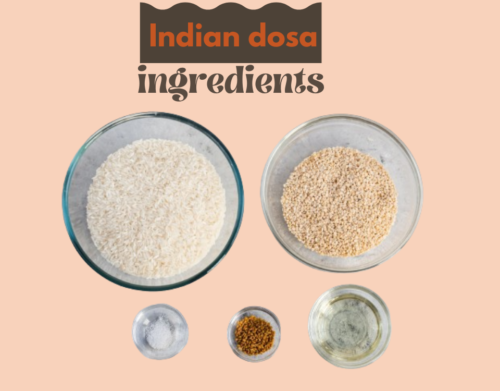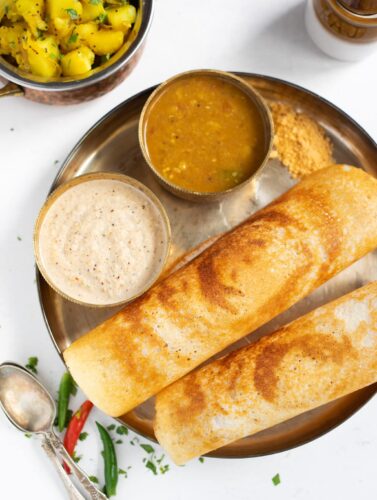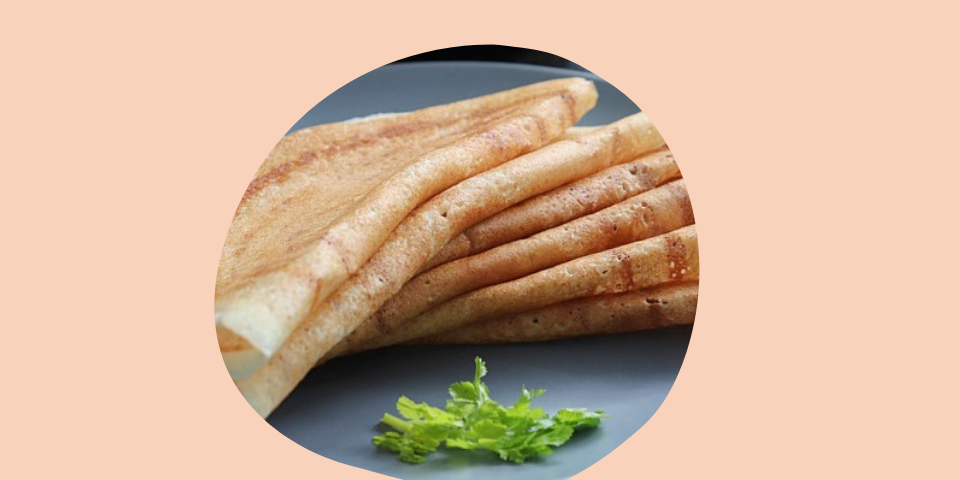
French crepe recipe
November 17, 2023
Healthiest Fast Food Burger: Smart Choices for Your Cravings
December 7, 2023Easy Indian dosa recipe
Learn easy Indian dosa recipe at home using rice, urad dal & fenugreek. A simple, authentic South Indian recipe perfect for any meal!
Ingredients
Learn how to make the perfect crispy dosa at home with this simple, traditional Indian recipe! Using just a few ingredients like rice, urad dal, and fenugreek seeds, you’ll get thin, golden dosas that are light, flavorful, and great for breakfast, lunch, or dinner.
To make the perfect dosa, you’ll need:
- 2 cups of rice
- 1 cup of urad dal (black gram)

- 1/2 teaspoon fenugreek seeds
- Water
- Salt to taste
- Vegetable oil or ghee for cooking
Step 1: Soaking
Let’s kick off by washing the rice, urad dal, and fenugreek seeds separately. Toss them into a bowl and let them soak in water for at least 4 hours. This ensures the grains absorb enough water to create a smooth batter.
Step 2: Grinding
After the soaking magic, grind the mixture into a smooth, thick batter. Add water bit by bit until you reach that perfect consistency. Remember, we’re aiming for a batter that’s not too thick or too runny – just right!
Step 3: Fermentation
Transfer the batter to a bowl, sprinkle in some salt, and let it rest and ferment overnight or for at least 8 hours. This fermentation process is the secret behind the dosa’s unique and tangy flavor. Patience is the key here!
Step 4: Preparing the Griddle
Time to heat your non-stick or cast-iron griddle (tawa) on medium heat. Wondering if it’s ready? Sprinkle a few drops of water – they should sizzle and dance on the surface.
Step 5: Making the Dosa
- Take a ladleful of batter and spread it in a circular motion on the hot griddle.
- Drizzle some oil or ghee around the edges for that delightful crispy texture.
- Cook until the edges turn a beautiful golden brown, and the dosa lifts easily.
Step 6: Folding and Serving
Now comes the fun part! Fold the dosa into a half-moon or roll it into a cylinder, letting out that irresistible aroma. Serve it piping hot with coconut chutney or sambar for the ultimate dosa experience.
There you have it – your easy guide to crafting delicious dosas at home! Enjoy every bite of this South Indian delight, and don’t be afraid to get creative with your favorite fillings or sides. Happy cooking!

Pro Tips for Perfection
-
Use a 2:1 ratio of rice to urad dal.
-
Ferment in a warm spot for better rise and tang.
-
Spread batter thinly on a well-heated pan.
-
Don’t use too much oil — just enough to crisp the edges.
-
Use a flat spatula to flip the dosa delicately for an even cook.
Now, enjoy your homemade dosa, and savor the authentic flavors of this South Indian delight!
What is dosa batter made of?
Dosa batter is a fermented batter made from rice and urad dal (black gram). Fenugreek seeds are often added for flavor. The batter is then fermented for several hours, which gives it a sour taste and makes it easier to digest.
What is the secret of crispy dosa?
- Batter: Use the right rice and lentil ratio (2:1), ferment for 8-12 hours, grind smoothly.
- Cooking: Use a well-seasoned pan, heat to medium-high, spread batter thinly and evenly, add a little oil, and flip once golden brown.
- Equipment: Cast iron pan or nonstick tawa, ladle or batter spreader.
Crispy dosa secrets:
- Batter: Use the right rice and lentil ratio (2:1), ferment for 8-12 hours, grind smoothly.
- Cooking: Use a well-seasoned pan, heat to medium-high, spread batter thinly and evenly, add a little oil, flip once golden brown.
- Equipment: Cast iron pan or nonstick tawa, ladle or batter spreader.
Which batter is best for dosa?
The best batter for dosa is a combination of rice and urad dal (black lentils) that has been fermented for at least 8-12 hours. The ideal ratio of rice to urad dal is 2:1, and the fermentation process helps to break down the starches in the batter, making it easier to spread and resulting in a crispier dosa.
Why is dosa batter, not crispy?
There are several reasons why your dosa batter might not be crispy. Here are some of the most common ones:
- Insufficient fermentation: Fermentation is crucial for achieving a crispy texture in dosa. The batter needs to be fermented for at least 8-12 hours in a warm place. If the batter is not fermented enough, the dosa will be soft and chewy.
- Incorrect batter consistency: The dosa batter should be of a thin consistency. If the batter is too thick, it will result in a thicker and softer dosa.
- Inadequate heat: The griddle or tawa should be preheated well before pouring the batter. If the tawa is not hot enough, the dosa will not cook properly and will not be crispy.
- Too much oil: Adding too much oil to the batter can make the dosa greasy and prevent it from crisping up.
- Old or stale rice: Using old or stale rice can make the dosa hard and chewy.
Here are some tips for making crispy dosa:
- Ferment the batter for at least 8-12 hours in a warm place.
- Use a thin batter consistency.
- Preheat the griddle or tawa well before pouring the batter.
- Add a small amount of oil to the batter, but not too much.
- Use fresh rice.
- Spread the batter thinly and evenly on the griddle or tawa.
- Cook the dosa until it is golden brown and crispy.
- Flip the dosa and cook for an additional 30 seconds to 1 minute.
- Serve immediately with your favorite chutney or sambar.
With a little care and attention, you can make crispy and delicious dosas at home!
Is dosa healthy or unhealthy?
Yes, dosa is a healthy food that is high in carbohydrates, protein, and fiber. It is also low in calories, fat, and cholesterol. Dosa is a good source of essential vitamins and minerals, such as iron, calcium, and magnesium.
What is the main fermenting agent for dosa batter?
The main fermenting agent for dosa batter is a type of bacteria called Lactobacillus. These bacteria are found naturally in the rice and urad dal (black lentils) that are used to make dosa batter. When the rice and urad dal are soaked in water, they release natural sugars that the Lactobacillus bacteria can ferment.
FAQ
Q: What is dosa batter made of?
Dosa batter is made from fermented rice and urad dal, often with fenugreek seeds for flavor and better fermentation.
Q: What’s the secret to crispy dosa?
A thin, smooth batter, proper fermentation, and a hot, seasoned pan. Use minimal oil and spread the batter evenly.
Q: Which batter is best for dosa?
The best batter uses a 2:1 rice to urad dal ratio, fermented for 8–12 hours. This makes dosas crisp, light, and easy to digest.
Q: Why isn’t my dosa crispy?
Possible reasons: under-fermented batter, thick consistency, cold pan, or too much oil.
Q: Is dosa healthy or unhealthy?
Dosa is healthy — it’s low in fat, high in protein, fiber, and natural carbs. A great choice for a light, balanced meal.
Q: What is the main fermenting agent in dosa batter?
Lactobacillus bacteria naturally present in rice and lentils cause fermentation, making the batter airy and easier to digest.


